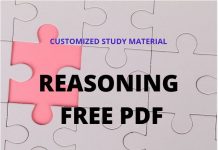 For Daily Job Alert For Daily Job Alert |
Join Our Whats App Channel |
 For Free Study Material For Free Study Material |
Join Our Telegram Channel |
Directions (Q. 1-5): In the given questions, assuming the given statements to be true, find which of the given three conclusions numbered I, II and III is/are definitely true and give your answer accordingly.
(1-2):
Statements: T≥Q<R=P,N≤R,L≥S=N
Q1. Conclusions: I.T≥N II.R≥S III.L≥R
(a) Only I is true (b) Only II is true (c) Only I and II are true (d) Only II and III are true (e) None is true
Q2. Conclusions: I.R>L II.L>P III.N≤Q
(a) Only I and III are true (b) Only II is true (c) Only III is true (d) Only I and II are true (e) None is true
Q3. Statements: D = C ≥V>K≥M,W≥E=G>M
Conclusions: I.D>M II.M<W III.C≥E
(a) Only I and III are true (b) Only II is true (c) Only III is true (d) Only I and II are true (e) None is true
(4-5):
Statements: S≤N≤P=T>R,Q>V≥W=K>P
Q4. Conclusions: I.S<K II.Q>W III.W≥P
(a) Only I is true (b) Only I and II are true (c) Only II is true (d) All I, II and III are true
(e) None is true
Q5. Conclusions: I.K>R II.T≤V III.W>R
(a) Only I and II are true (b) Only III is true (c) Only I and III are true (d) Only II and III are true
(e) None of these is true
Directions (Q. 6-10): In each question below are given three statements followed by three conclusions numbered I, II and III. You have to take the given statements to be true even if they seem to be at variance with commonly known facts. Read all the conclusions and then decide which of the given conclusions logically follows from the given statements, disregarding commonly known facts.
Q6. Statements: All bags are files. No file is a book. Some notes are bags.
Conclusions: I. At least some notes are files. II. All files being notes is a possibility. III. No bag is a book.
(a) Only I follows (b) Only II and III follow (c) All I, II and III follow (d) Only II follows
(e) None of these
(7-8):
Statements: No fruit is a leaf. All trees are leaves. Some trees are branches.
Q7. Conclusions: I. Some trees are not fruits. II. Some branches are not trees. III. At least some leaves are fruits.
(a) Only II follows (b) Only I follows (c) Only II and III follow (d) Only I and II follow (e) None of these
Q8. Conclusions: I. All branches being leaves is a possibility. II. Some fruits are not branches.
III. At least some leaves are trees.
(a) Only I follows (b) Only II and III follow (c) Only I and III follow (d) Only I and II follow
(e) None of these
Q9. Statements: All chapter are lessons. Some lessons are books. No paper is a book.
Conclusions: I. All chapter are books. II. Some lessons are not papers. III. At least some chapters are papers.
(a) Only II follows (b) Only I and III follows (c) Only II and III follow (d) Only I follow (e) None of these
Q10. Statements: No bucket is a glass. No cup is glass. All spoons are buckets.
Conclusions: I. No spoon is a glass. II. No bucket is a cup. III. Some glasses are cups.
(a) Only II follows (b) Only III follows (c) Only I follow (d) Only I, II and III follow (e) None of these
Direction (Q. 11–14): Study the following information carefully and answer the given question:
‘P × Q’ means, ‘P’ is mother of ‘Q’.
‘P ÷ Q’ means, ‘P’ is son of ‘Q’.
‘P + Q’ means, ‘P’ is brother of ‘Q’.
‘P – Q’ means, ‘P’ is wife of ‘Q’.
Q11. If A is daughter–in–law of B then what should come in place of (?) in the given expression ?
A – O ? N – B ÷ R
1) × 2) – 3) ÷ 4) + 5) None of these
Q12. How is M related to J in the given expression ?
J × K + L – M ?
1) Son–in–law 2) Son 3) Daughter 4) Can’t be determined 5) None of these
Q13. In which of the following expression will be the expression R is father–in–law of T ?
1) T – L ÷ M + N ÷ R 2) T – L ÷ M × N ÷ R 3) T – L ÷ M – N ÷ R 4) Can’t be determined 5) None of these
Q14. If the expression A – B + C ÷ D × E is true, what is the relation between E and A ?
1) E is brother–in–law of A 2) E is husband of A 3) A is sister–in–law of E 4) Can’t be determined
5) None of these
Directions: Study the following information carefully and answer the questions given below
Seven family members, viz – A, B, C, D, E, F and G are sitting around a circular table facing the centre, but not necessarily in the same order. Among them four are males and three are females.
Grandfather is the immediate neighbor of his son and his grandson E, who is sitting on the immediate left of his wife. The wife of A is third to the left of her father–in–law. C is the father–in–law of F. D is brother of A. B is the daughter of A is sitting fourth to the right of A. A is son of C. B is not a neighbor of any male.
Q15. Which of the following group represent females according to the given arrangement ?
1) A, D, F 2) G, B, F 3) G, B, E 4) C, E, F 5) Can’t be determined
Q16. Who is the grand father of E ?
1) A 2) B 3) C 4) Can’t be determined 5) None of these
Q17. Which of the following sits second to the right of D ?
1) C 2) B 3) F 4) E 5) A
Q18. Which of the following statements (s) is/are true with respect to ‘G’ ?
1) G sits to the left of E and is a male. 2) G is wife of E. 3) G is daughter of A. 4) G is brother of A and B.
5) G is sister of D.
Q19. Which of the following pairs sit between D and G ?
1) A, B 2) B, E 3) C, A 4) F, E 5) B, F












